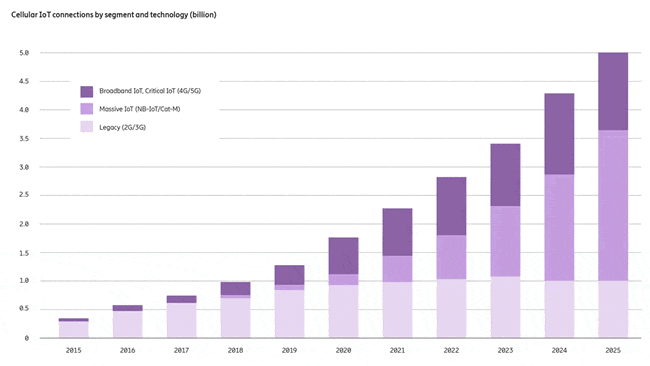Narrowband IoT or NB-IoT is a wireless communication standard for the Internet of Things in its different forms. NB-IoT belongs to the category of low-power wide-area networks (LPWAN), enabling to connect devices that need small amounts of data, low bandwidth, and long battery life. This makes it suitable for a variety of applications and use cases for IoT.
NB-IoT (Narrowband-IoT) is a narrowband radio technology for M2M and Internet of Things (IoT) devices and applications requiring wireless transmission over a more extended range at a relatively low cost and using little power for long battery lives.
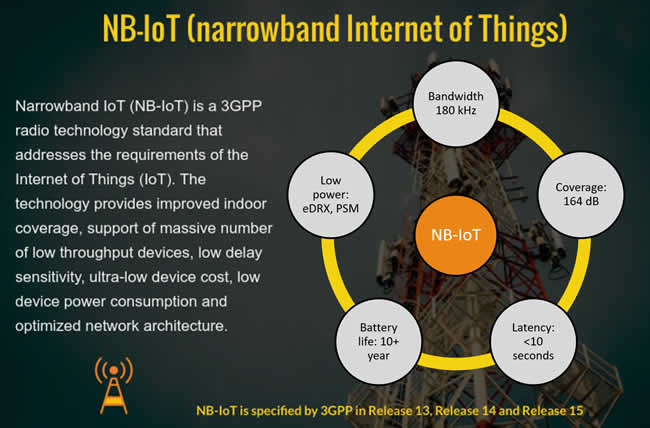
In NB-IoT applications, typically small data volume amounts need to be infrequently transmitted. NB-IoT became a standard for this type of wireless communications in 2016, and in recent years mobile operators have been, and many still are deploying network capabilities enabling narrowband-IoT coverage for their customers.
IoT applications that require more frequent communications will be better served by NB-IoT, which has no duty cycle limitations operating on the licensed spectrum (ABI Research)
NB-IoT is, among others, also referred to as LTE Cat-NB. Other terms such as LTE Cat-NB1 and Cat N1 apply to the NB-IoT specification released in 2016. Today, there are also Cat N2 or Cat NB2 devices that use the enhanced NB-IoT specifications that came later and are currently on the road towards commercialization.
According to ABI Research, by 2026, NB-IoT and LTE-M will capture over 60% of the 3.6 billion LPWA network connections. Of the remaining 40% share, LoRa and Sigfox will account for over 80% of the non-cellular LPWA network connections.
NB-IoT falls under the category of LPWA network standards and protocols (LPWAN). That’s the name used for many types of wireless IoT communication standards in the IoT stack that enable to use devices with batteries for transmission over a wide area (wide area network or WAN, in this case WWAN or wireless WAN) with relatively low power (hence the ‘LP’) for infrequent, mainly small data volume, transmissions.
NB-IoT: the mobile industry’s response to non-cellular LPWAN
NB-IoT and two other standards in the LPWAN family (although not everyone agrees all belong to that family, yet it’s broadly accepted) are the first and for many years to come only cellular LPWAN standards (with 5G and IoT on the horizon).
Cellular simply means that they use cellular technologies, just like smartphones, for example. A cell is essentially an area covered by a cell site, and when you travel, there is a handover between cells.
The two other cellular LPWAN standards are eMTC (now generally called LTE-M) and EC-GSM-IoT. Together, these standards were often referred to as ‘Mobile IoT,’ although that term is confusing since older mobile cellular technologies already were and often still are used for M2M and IoT.
From a practical viewpoint the consequence of the arrival of the cellular LPWAN standards is that traditional – cellular – mobile operators offer NB-IoT (often on top of a non-cellular one, mainly LoRaWAN and/or alongside LTE-M) and that has some benefits/consequences which are inherent to cellular network technologies (e.g., QoS or Quality of Service) and to working with operator networks and their business ecosystems.
NB-IoT can be deployed ‘in-band’, utilizing resource blocks within a normal LTE carrier, or in the unused resource blocks within a LTE carrier’s guard-band, or ‘standalone’ for deployments in dedicated spectrum
So-called non-cellular LPWAN standards are available through various types of companies and players, depending on your region. In the case of one of these non-cellular standards, LoRa, you will find many mobile operators offer it as well for historical, practical, and business reasons, which would take us way too far for the scope of an article on NB-IoT. Other non-cellular options on top of LoRa and LoRaWAN, include Sigfox. LoRa and Sigfox account for the majority of non-cellular LPWAN connections (and until at least 2023, and probably later, of LPWAN connections overall).
Just like other cellular standards, NB-IoT uses licensed spectrum (non-cellular LPWA network technologies use unlicensed spectrum). NB-IoT uses a subset of LTE (Long-Term Evolution, let’s say a standard for 4G wireless broadband, although that’s a simplification) and can be deployed in three different ways.
In case you are familiar with one or more of the non-cellular LPWAN options such as LoRa(WAN), you can see NB-IoT as the mobile industry’s most immediate answer to these offerings.
NB-IoT and Massive IoT
In practice, you will mainly see comparisons between NB-IoT and LTE-M though because these are the two options the mobile industry ecosystem of manufacturers, service providers, and network operators pushing both want you to select between and because it makes sense from the cellular perspective.
In case LPWAN is new to you, or when you see someone claim that it is new, this isn’t because it effectively is a new wireless IoT communications category at all but because, after many years of delay which are mainly related to different technologies being proposed and the business choices of the mobile industry the cellular LPWA networks are here in many regions.
LPWAN is sometimes also categorized under the term, Massive IoT, another industry term that just means those ‘billions’ of devices that typically transmit small data volume amounts, often sent at intervals (so no constant transmission but now and then) and with the need for long battery lives as with NB-IoT and others.
Before talking specifications, use cases, developments, and more, a few words on the specifications and standardization that might help understand some details in case you’re interested. The standardization body of the mobile (cellular) industry, known as 3GPP (3rd Generation Partnership Project), works with numbered ‘releases’ in which specifications of new standards and enhancements are frozen at a specific moment in time. These releases cover several mobile technologies members (the mobile industry) have worked on.
- The specifications of NB-IoT were frozen in ‘release 13’: LTE Cat-NB1.
- With release 14, the earlier mentioned enhanced specifications were added: LTE Cat-NB2 (and far more acronyms for the same).
- Power-saving modes that can be used in the standards go back to a release earlier.
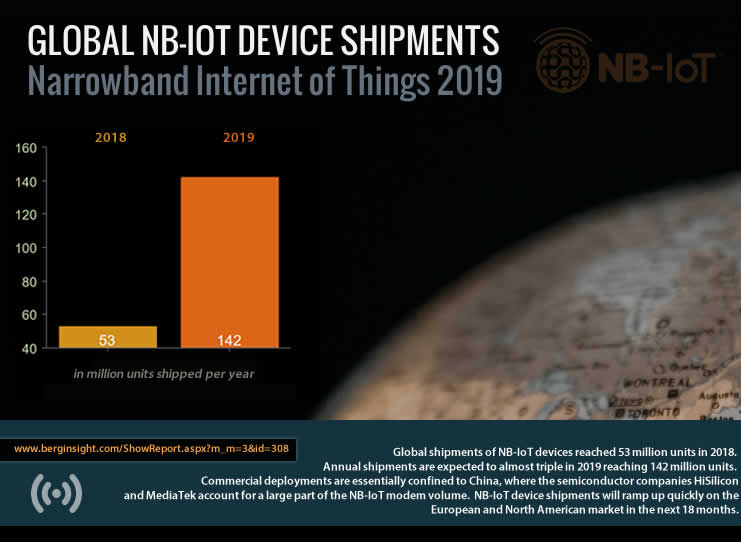
NB-IoT and LTE-M: some differences between the main cellular LPWAN options
Let’s look at some typical differences between NB-IoT and LTE-M since that’s an often-asked question without getting too technical (for now, more in-depth technical details will be added).
Important before we start, even if it may be obvious: when you want to know which LPWAN or, broader, communication standards for IoT fit your needs best and if NB-IoT is right for your project, don’t just look at features and technical specifications. Also, beware of the sources of the information you seek as commercial interests nowadays are high.
While early deployments have so far been focused on traditional verticals such as smart metering, we expect to see NB-IoT being integrated into a broader set of products in 2019–2020, including home appliances, door locks and smoke detectors (Fredrik Stalbrand, Senior Analyst, Berg Insight)
At all times, contact a trusted partner for the region(s) you want to cover with your application. Features are often expressed in theoretical possibilities and maxima, not considering the ways your application is set up.
This is particularly so with speeds and battery lives (there are several ways to save energy, but some might not fit your case). Connectivity also fits in a broader picture and, finally, the reliability, quality, and management of the network as well as the roadmap of your potential partner and their ecosystem of partners matter. In fact, chance is high you already work with a partner in the ecosystem of operators or connectivity providers for other projects. The business case and your project’s success are essential.
With this said, some characteristics of NB-IoT compared to LTE-M and other LPWA network options.
NB-IoT: less ‘powerful’ than LTE-M
Of the two primary cellular LPWAN standards that are available in networks now (namely NB-IoT and eMTC/LTE-M), NB-IoT is the least ‘powerful’ one in terms of speed, data transfer capabilities, support for truly mobile use cases and more; in other areas, it’s better.
The setup of NB-IoT data architecture and key features can affect the performance of a NB-IoT device, its cost and even its ability to roam
In general, this means that NB-IoT will be used more in applications that resemble those deployed in projects where non-cellular standards are often found. Examples include smart agriculture, several smart city applications (e.g. smart parking, smart street lighting, waste management), some smart home applications, smart meters (and given indoor penetration, see below, submetering), manufacturing automation, smart grid applications, smoke detectors, industrial IoT applications with many low-power devices, also in Industry 4.0 with for example condition monitoring and even predictive maintenance, smart locks, environmental monitoring, trackers and more.
So, a broad range indeed since many use case categories contain several more, and this list isn’t exhaustive. And indeed, to no small extent, an overlap between use cases in non-cellular LPWAN and NB-IoT. However, there are other elements, too.
Latency of NB-IoT
NB-IoT is less suited for circumstances where network latency needs to be very low when compared with LTE-M.
So, you will find it less in applications where near-real-time data might be required, in which case LTE-M is a better fit. Both NB-IoT and LTE-M have a role in the road towards 5G, where extremely low network latency enables use cases that need speed and are typically critical. The choice of the communication standard is not the only element here.
The advantages of the NB-IoT technology include low energy consumption and high reliability in areas with coverage challenges
By the way: if you need to rapidly analyze specific sensor data for one reason or the other, and this isn’t specifically about communication technologies, do look at edge computing and IoT. Essentially, edge computing enables you to analyze data closer to the source and before there is any communication to some cloud or data center whatsoever (if that’s even needed).
Back to NB-IoT: latency is typically equal to or less than 10 seconds (around 1.6 to 10 seconds). With LTE-M, we talk about delays of 100 to 150 ms.
NB-IoT and mobility
As opposed to LTE-M, NB-IoT has no full support for mobility (LTE-M also supports voice). This refers to our cells and handover, although there have been changes since 3GPP Release 13 (Release 14 has some improvements as in many characteristics of NB-IoT).
Still, NB-IoT is more prevalent in applications and use cases with fixed (stationary) assets and devices. You might have noticed this in the types of applications and use cases we mentioned above. Attention: that doesn’t mean NB-IoT can’t be used for assets and devices that are mobile as we sometimes hear; it’s just limited. There are, for example, real-live NB-IoT applications with trackers, shared bicycle applications, environmental applications with a moving component but little throughput, smart logistics and more.
A bit more technical: with NB-IoT, the device needs to reselect the cell as it travels; with LTE-M, this isn’t the case. So, it’s far less suited for mobile (and the reselection of cells has an impact on battery life as it consumes power). In general, fixed assets such as those smart meters or point of sales terminals, to add another, are the typical area of NB-IoT but not the sole – and for ‘real seamless mobility’ it’s LTE-M.
NB-IoT: focus on energy efficiency
NB-IoT is also more focused on low energy usage and thus low power than LTE-M which is also related to the fact that LTE-M is the more powerful option.
This is essential for your IoT project. If you use many IoT devices with batteries, then the overall cost of your project increases if these batteries need faster replacing. An example that was mentioned by Tom Casaer, whose company AllThingsTalk has been working with many operators for the roll-out of their LPWA networks and offering: in The Netherlands, there is an IoT project with rat traps to protect the many dikes in the country. If you need to replace batteries in all the hardware in that project or similar ones, costs are high because that’s a manual job, it’s a service. So, the longer the battery life, the higher the ROI and the overall value of the business case. Very low power also means far more use cases that are possible with potentially vast numbers of devices.
NB-IoT theoretically offers up to or even little over 10 years of battery life. It is better than LTE-M in this regard. Beware, it can be far less than ten years so that you could be in for a big surprise (we read about some alarming cases, but you’ll have to check with your partner for your project).
Ample settings for your application will define actual battery life, including the usage of the energy-saving options (eDRX and PSM or Power Saving Mode), which we tackle in-depth later, or the usage of NB-IoT capabilities in your project such as cell reselection as mentioned and more, some examples below. Up to 10 years (and many say even a bit more is possible) is marketing, and at all times, your application must be checked for settings and options that could consume power, perhaps even without knowing it, where such isn’t needed. Oh: it also depends on the batteries and how these can evolve of course as well, and, yes, there are ways to increase battery life and specific power source innovations.
NB-IoT and indoor/underground penetration
An essential factor for you might be the indoor penetration capabilities of NB-IoT (and enhanced reach overall).
One NB-IoT base station cell is estimated to have the capacity to support thousands of devices using an NB-IoT connection
An example that is typically used by the industry is that of smart meters in basements (remember submetering) from the indoor penetration perspective. It’s also reasonable to use that example since smart meters drive the LPWAN market (but that means ALL approaches and standards, including non-cellular options and smart meters, can mean many things so you can have different technologies used for different meters in different applications in a – more or less – same region for various reasons, which again would bring us too far).
Since NB-IoT uses narrowband (or a narrower bandwidth and a single narrow band of 200KHz or 180KHz to be precise), it allows for an increased density of transmission power and that, along with other coverage enhancement capabilities, is what makes indoor penetration and reach overall better.
Think buildings, remote and hard to reach locations, and even underground to an extent. LTE-M is suitable for indoor coverage too but NB-IoT is better. Technical stuff regarding reach and penetration or, in one word, coverage: maximum coupling loss of NB-IoT is 164 dB, which is a 20 dB better link budget compared to GPRS.
More NB-IoT features
Other characteristics: NB-IoT doesn’t offer the same degree of bi-directionality as LTE-M (half-duplex).
It does enable firmware updates over the air (but again with an impact on power consumption and thus those ten years) and as a cellular technology it comes with benefits regarding quality of service (QoS) and security.
The average data rate (downlink speed and uplink speed) obviously depends, and various average data rates have been reported. They are usually lower than the maxima of course.
NB-IoT across regions
NB-IoT was initially deployed in Europe and Asia. Just as is the case for many wireless IoT protocols, not only of the LPWAN kind, the leading market for NB-IoT by far today is China, however.
In the US and North America, operators deployed LTE-M networks first. Although most initially didn’t intend to, they also have rolled out an NB-IoT offering now, some such as AT&T and Verizon in 2019. In Europe, many operators are currently working further on LTE-M after their NB-IoT rollouts. Some offer non-cellular LPWAN (LoRa) in combination with LTE-M and even now and then with NB-IoT too. The strategies differ, not just per operator but also sometimes per operator per country for local reasons.
By 2026, NB-IoT and LTE-M will capture over 60% of the 3.6 billion LPWA network connections
All these evolutions aren’t that surprising or strange as might seem. There are also various reasons why in the US, operators started with LTE-M and rolled out NB-IoT later, even if they didn’t want. Which cellular networks existed where and which networks were (about to be) shut off is one reason.
Among the reasons why LTE-M was recommended and first deployed in the US is the fact that there was already ubiquitous 4G coverage in North America. LTE-M essentially is a ‘light’ version of LTE.
NB-IoT was a different ballgame. You could say it’s ‘new’ with various formats having been proposed starting 2014. It reuses several techniques from LTE and was designed to offer an enhanced cellular alternative for existing non-cellular LPWA standards, with the support for various market scenarios different than the situation in the US.
NB-IoT deployments have been delayed for several years and still are. Some operators have a wait and see attitude for various reasons. Some players have been very optimistic regarding NB-IoT and how it would replace non-cellular offerings, but the latter isn’t going to happen in the short term as predicted many years ago.
We’ll mention a few because today they still have an impact (or might have one by the time you read this) and for the rest it’s like with all network standards and ‘wars’ we had throughout time: nice to know if you care, a lot is written on it but once things clear up and ‘winners’ are apparent after a few years only insiders remember and for companies using the standards/networks it doesn’t matter as connectivity becomes ubiquitous and a commodity.
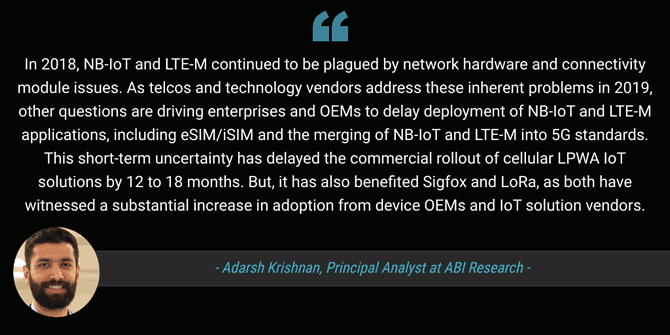
Elements that (have) play(ed) a role and seem worthy of mentioning:
There were several proposals for NB-IoT. In one the companies promoting it wanted to work further on LTE-M. Another wanted to build NB-IoT more or less from the ground up with a technology developed by a company called Neul.
Both were withheld, compatibility issues were the result and, although denied by some and emphasized by others, the fact is that these challenges led to problems and affected the market.
Given the fact that NB-IoT (and LTE-M) in practice for many are still relatively new, and there are ample companies involved in the component and hardware ecosystem as well, there have been several issues. In fact, according to ABI Research (June 2019), problems with network hardware and connectivity modules persisted in 2018 and are still addressed in 2019.
Another challenge is one that you’ll always see in the mobile industry (and others for that matter): money, margins, and, thus, also priorities. Low-power wide-area networks don’t represent a huge market in terms of spending (costs need to be low).
This isn’t just a factor that played a role in the decisions of stakeholders such as operators but also in the birth of the LPWAN ecosystem, to begin with (the non-cellular one, that is)
There was also little belief in the industry that there wouldn’t be a real LPWAN market opportunity and operators, and the industry as a whole looked more at the more significant revenue opportunities of the moment (and future), which certainly was beyond IoT. Moreover, existing (expensive) cellular technologies were used by clients (and even today, by far represent the majority of connections).
However, a market is a market, and sooner or later competitors, in this case of the non-cellular kind, start building an interesting little market you miss out on if, as a mobile cellular player, you don’t act. Hence why many operators offer an unlicensed band option for now at least and why many might continue to for some time given the previous challenge. Yet, it’s also hard for operators to monetize NB-IoT unless they are in a good position with partners, services and local market situations. But even then, it remains hard. And that’s again related to costs, SIM cards and mainly costs you don’t see. And, let’s face it, it’s not as if IoT is mainstream yet if you look at the market overall (global and including SMEs).
NB-IoT roaming: the first steps
Now that mobile network operators are increasingly deploying their NB-IoT networks, they also start inter-carrier roaming agreements just as they did with regards to LTE-M roaming.
NB-IoT operates in the licensed spectrum, and like LTE, uses Frequency Division Multiple Access (FDMA) in the uplink, Orthogonal FDMA (OFDMA) in the downlink, and Quadrature Phase Shift Keying (QPSK) modulation
A first roaming agreement was signed the end of October 2019 by AT&T and Vodafone Business, enabling NB-IoT roaming across the US and parts of Europe, in particular, the Vodafone networks in Spain, Germany, Italy, the UK, and the Netherlands. It’s not really massive roaming yet, but the roaming agreement between both carriers creates the largest NB-IoT footprint across the globe, available to customers of both operators since the end of 2019.
Obviously, more such NB-IoT roaming agreements will follow, enabling operations across several networks with a single SIM. In fact, Vodafone Business and AT&T, who also were the main initiators of the first LTE-M roaming agreement, say they want to expand their roaming footprints for both massive IoT cellular technologies on a similar level to 4G worldwide.
NB-IoT – the number of connections and networks
This page on NB-IoT is evolving is far from exhaustive since we’ll still cover all the technical details and more ways in which NB-IoT is used today.
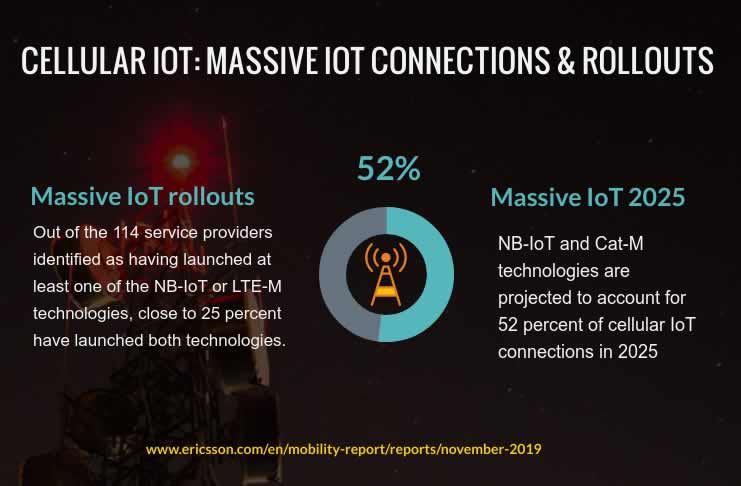
NB-IoT is not mainstream at all yet, though. If you’re interested in the reality of NB-IoT usage, it’s essential to differentiate between NB-IoT network rollouts and the number of operators offering NB-IoT on the one hand and actual connections on the other of course.
While this might seem obvious and goes hand in hand with marketing efforts, in this stage, it’s key as you can get very different pictures regarding the state of NB-IoT. This page will be updated to reflect the evolving market and provide more information about NB-IoT.
So, how many NB-IoT connections and networks are there? According to anupdate from the GSMA there were 34 LTE-M networks and 89 NB-IoT networks. End October 2019 the Ericsson Mobility Report November 2019 cited data from the GSA indicating that in total there are 114 service providers offering massive IoT connectivity with close to 25 percent of them having launched both NB-IoT and LTE-M.
As you can read in our article on massive IoT and the Ericsson report, the company expects a total of that by the end of 2025 NB-IoT and Cat-M/LTE-M will account for 52% of cellular IoT connections.
